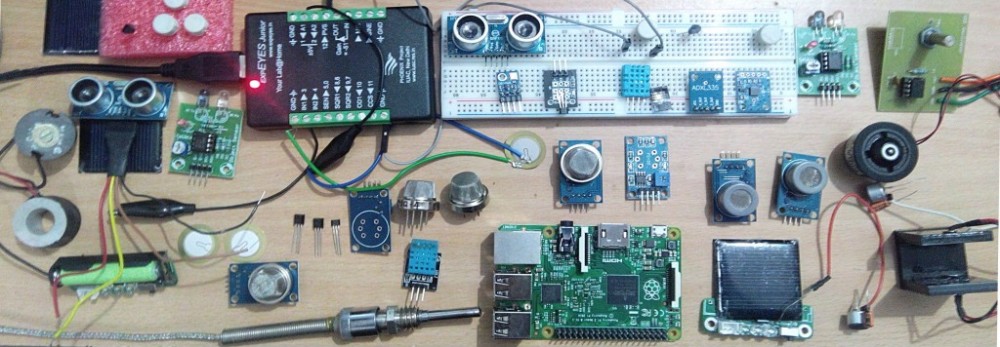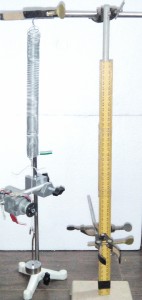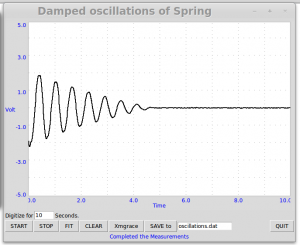( From Monday 14th July 2014 to Sunday, 20th July 2014)
This week I started setting up few new experiments with Spring Oscillations and Friction.
Experiment to investigate the damping effect of air, water and other viscous liquids on spring oscillations can be very interesting if done with a computer interface. Currently these set-ups are available for very high cost and come with proprietary and closed source software. They general use Rotary motion sensors which are costly. We could set up this experiment with low cost apparatus using ExpEYES. Tried using a simple DC motor to fetch the data and plot oscillations. ( we were using this method for digitizing pendulum waveform). After multiple trials now the setup is ready and got amazing results.
The schematic diagram and my home made set up is here…… ![]()
Here is the screen-shot of the waveform generated in water.
Repeated the experiment with other liquids like glycerin.
- Oscillations is a very important phenomena in physics and has an extremely wide range of occurrences. They are visible in the swinging and cushioning of cars or suspension bridges. In Nature, oscillation always occur as coupled ones. I started working on setting up an experiment with two spring pendulum to study oscillations of coupled pendulum. In this experiment we will try to get the characteristic frequencies and investigate the phenomenon of beat-vibration with two coupled spring pendulum.
- Conservation of energy is yet another important concept in mechanics. It can be demonstrated easily by calculating total energy of a body at different positions during its motion. We could do this experiment in two ways
- Using Ultrasocic sensor : SRF 05 module transmits a burst of ultrasonic pulses. The ultrasonic pulses reflect off a target and return to the face of the sensor. The sensor measures the time between the trigger rising edge and the echo rising edge. It uses this time and the speed of sound to calculate the distance to the object. To determine velocity, it uses consecutive position measurements to calculate the rate of change of position.
- Using Photogates : A photogate monitors the motion of objects passing through its gate, counting events as the object breaks the infrared beam. If the size of the object is known, by measuring the time an object blocks the gate, you can determine the velocity.
Also got the apparatus for energy conservation experiment prepared from local carpenter in wood. Its working fine. Wrote python program for the experiment. User can enter the value of initial height of the metal sphere, to calculate Potential energy. When the Sphere roles between two photo-gates, time can be measured with microsecond accuracy and velocity and hence kinetic energy can be calculated. The results show that Initial Potential Energy is equal to final Kinetic Energy and hence proves the Energy Conservation Theorem.
- Did required modifications in the main GUI program ” CROPLUS” written by Dr Ajith Kumar, to access these new experiments. Uploaded this program on my GIT repo. Also started writing a new program for a GUI to access these mechanics experiments separately.
As of now all the basic requirements i.e. the sensors and the required python programs to access them are ready. Also most of the physical set-ups are ready ( Excluding independent sine wave generator). Now I will be focusing on …redoing the experiments, debugging the errors and polishing and finalizing python code for each experiment.
To Do next week…
- Finalize all mechanics and sound experiment.
- Complete the required documents and publish them in repository.
- Start working on Integrated GUI for mechanics experiments.


